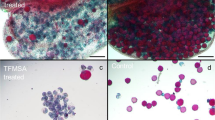Abstract
Hot water treatment was applied to Tartary buckwheat (var. ‘Hokkai T8’) for emasculation. Apical clusters of flower buds were soaked in a constant temperature water bath (42–44°C) in the afternoon and then the flowers which opened in the next morning were used for the investigation of self-fertilization and the artificial pollination. Hand pollination was carried out by rubbing the anthers taken from the male parent (var. ‘Hokkai T10’) to the stigma of the flowers treated by hot water. The seed set by self-fertilization was almost 0% when treated at 42°C for 8 min or more, at 43°C for 5 min or more and at 44°C for 3 min or more. With artificial pollination, the best performance was obtained when treated at 44°C for 3 min, in which the seed set was 55.1% and the matured seed was obtained 37.7% of the hand-pollinated flowers. Nine out of 26 progeny seedlings emerged and the cotyledonal color of them were all reddish green, probably indicating the hybrid of ‘Hokkai T8’ and ‘Hokkai T10’. The hybridization was reconfirmed by the segregation in F2. The hot water treatment at 44°C for 3 min was available to other seven varieties. From 24.5% to 100% of the hand-pollinated flowers set mature seeds though only one self-fertilized seed remained without artificial pollinations. This hot water treatment must be practically useful in hybridization breeding of Tartary buckwheat.

Similar content being viewed by others
References
Fujita K, Inoue N, Yang Z, Hagiwara S, Hagiwara M (2003) Varietal differences of antioxidant activity in Tartary buckwheat flour as evaluated by chemiluminescence. Fagopyrum 20:47–52
Fujita K, Inoue N, Hagiwara S, Yang Z, Kato M, Hagiwara M (2004) Relationship between antioxidant activity and flour and hull color in Tartary buckwheat. Fagopyrum 21:51–57
Kitabayashi H, Ujihara A, Hirose T, Minami M (1995) On the genotypic differences for rutin content in Tartary buckwheat, Fagopyrum tataricum Gaertn. Breed Sci 45:189–194
Mukasa Y, Suzuki T, Honda Y (2006) Emasculation of self-pollinating buckwheat using hot water. Breed Res 8:177–181 (in Japanese)
Nandini R, Fakrudin B (1999) Emasculation in finger millet using hot water. J Agric Sci 33:6–10
Suzuki T, Honda Y, Funatsuki W, Nakatsuka K (2004) In-gel detection and study of the role of flavonol 3–glucosidase in the bitter taste generation in Tartary buckwheat. J Sci Food Agri 84:1691–1694
Wang Y, Campbell CG (2000) Breaking dormancy in buckwheat. Fagopyrum 17:45–50
Wang Y, Scarth R,Campbell C (2002) Interspecific hybridization between Fagopyrum tataricum (L.) Gaertn. and F. esculentum Moench. Fagopyrum 19:31–35
Wang Y, Campbell CG (2004) Buckwheat production, utilization, and research in China. Fagopyrum 21:123–133
Yamada M (1991) Pollination and fertilization. In: Noguchi Y, Kawada S (eds) Agricultural encyclopedia 2nd edn. Yokendo, Tokyo, pp 959–962 (in Japanese)
Yasuda T, Nakagawa H (1994) Purification and characterization of the rutin-degrading enzymes in Tartary buckwheat seeds. Phytochemistry 37:133–136
Acknowledgments
The authors thank Mr. Nakamura and Mr. Suzuki for their maintenance of the potted Tartary buckwheat in a greenhouse. This study was partly supported by the Northern Advancement Center for Science and Technology and Cooperation of Innovative Technology and Advanced Research in Evolutional Area (CITY AREA).
Author information
Authors and Affiliations
Corresponding author
Rights and permissions
About this article
Cite this article
Mukasa, Y., Suzuki, T. & Honda, Y. Emasculation of Tartary buckwheat (Fagopyrum tataricum Gaertn.) using hot water. Euphytica 156, 319–326 (2007). https://doi.org/10.1007/s10681-007-9377-7
Received:
Accepted:
Published:
Issue Date:
DOI: https://doi.org/10.1007/s10681-007-9377-7




